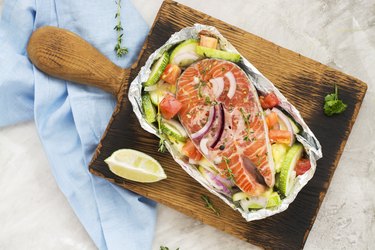
When old standby methods of preparation result in boring vegetable side dishes served over and over again, kick up the presentation and flavors with vegetable foil packets in the oven. This simple cooking method is ideal for busy households.
Tip
Create a kid-friendly vegetable mixture by stirring pizza sauce or spaghetti sauce into the veggies before baking them in foil. Top the cooked vegetables with a sprinkling of grated cheese just before serving.
Video of the Day
Foil packets take minimal time to assemble, and there are no stirring, turning or fussy stove top maneuvers left to accomplish. In the warmer months, consider grilling your veggies in foil packets, as described by the USDA.
Video of the Day
Choose Fresh Seasonal Veggies
Gather the ingredients for your veggie foil packet recipe. Clean all vegetables and cut away any bruised or damaged areas to help prevent foodborne illness, as instructed by the Centers for Disease Control and Prevention. Wipe dry with a paper towel.
Clean and cut zucchini and summer squash into ½- to 1-inch-thick slices. Add scrubbed, small new potatoes cut into quarters or eighths, bite-sized red bell pepper pieces and sliced onion for a classic foil-wrapped vegetable combination.
Adjust the mix to accommodate the type of vegetables that are in season, such as fresh snow pea pods and green onions. Frozen vegetables, like whole green beans, may be included for greater variety.
Season Your Veggies
Place the prepared vegetables in a large mixing bowl. Drizzle about a tablespoon of Italian-style salad dressing per cup of vegetables into the bowl. Alternatively, season the veggies with minced garlic, dried or fresh herbs or dry onion soup mix to suit your taste preferences.
If you are not using dressing, add 1 tablespoons of water or about 2 teaspoons of olive oil per cup of vegetables to the bowl. Stir the vegetables until all the components are evenly distributed.
Prepare Your Foil Packets
Lay sections of heavy-duty aluminum foil, about 14 to 16 inches long, on the counter to make individual vegetable servings. To prepare multiple servings all at once as a family-size vegetable dish, lay out one sheet of aluminum foil that's 20 to 24 inches long.
Spoon 1 to 1 1/2 cup of the seasoned vegetables onto the foil's center for an individual serving. Lift two opposite edges of the foil sheet and fold them together in 1-inch increments. Roll each of the remaining open sides toward the center, pressing each fold tightly with your fingers to form an enclosed packet.
For family-size servings, place up to 3 cups of the vegetables on a larger sheet of foil and fold it together to form a packet.
Read more: Do Vegetables Lose Nutrients When Cooked?
Bake and Serve
Place the foil packets, folded sides up, on the center rack of an oven that has been preheated to 375 degrees F. Bake the vegetables for 30 to 35 minutes. Some of the vegetables should be browning at this stage.
Remove the foil packets from the oven and set them on a plate. Use caution when opening as the foil is filled with hot steam, as advised by University of Nebraska-Lincoln Institute of Agriculture and Natural Resources.
Poke four or five holes in the foil at the top of each packet to allow the steam to escape. After five minutes, unfold the foil carefully to serve the vegetables.
Warning
Leafy green vegetables like spinach and chard do not hold up well to foil-wrapped cooking in the oven. Limit their use to small quantities added for color in a mix of more robust vegetables.